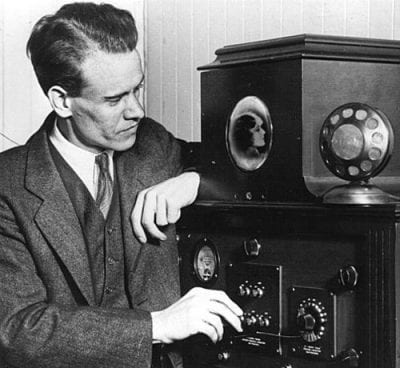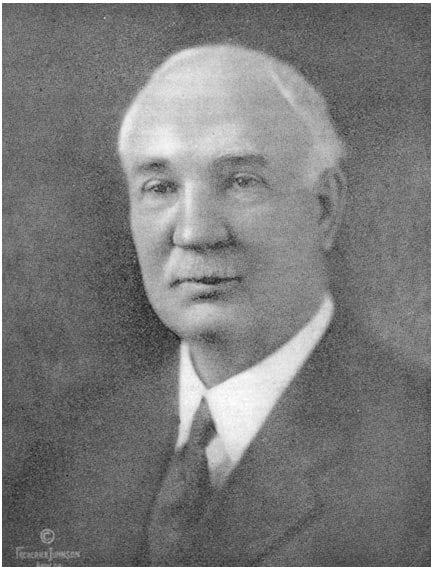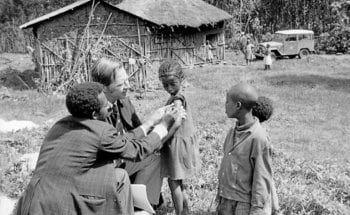Philo T Farnsworth (1906-1971) was a Mormon farm boy who is the undisputed inventor of television yet he made little money and got little credit for his efforts. Instead he was tied up in litigation by David Sarnoff and his RCA corporate lawyers, and, although he eventually was ruled the sole inventor of TV by the US Patent Office, he collected precious few royalties from Sarnoff and RCA before his patent expired in 1947 shortly before the post war boom in TV sets really took off. In 1935 the US Patent Office declared that Farnsworth was the undisputed inventor of TV. However Sarnoff and RCA tied Farnsworth up in litigation that prevented Farnsworth from marketing a single TV set. Then along came World War II which prevented Farnsworth from pursuing his commercial venture. After the war Farnsworth had two years to market and collect royalties before his patent expired in 1947 and TV became public domain. It wasn’t until after 1947 that TV sales really took off with the result that RCA didn’t have to pay royalties to Farnsworth at all and most of the profits went to RCA. Farnsworth eventually died depressed and alcoholic having spent his life dedicated to his invention. The basic history of the invention is the following:
At 202 Green Street, at the corner of Sansome, Philo T. Farnsworth invented television. At 14, plowing his father’s potato field in Idaho, he noticed the furrows lined up in neat parallel rows. For the rest of us a furrow is a furrow is a furrow, but the young Farnsworth saw something else. Mowing hay in rows, Philo realized an electron beam could scan a picture in horizontal lines, reproducing the image almost instantaneously. This would prove to be a critical breakthrough in Philo Farnsworth’s invention of the television in 1927.
Earlier TV devices had been based on an 1884 invention called the scanning disk, patented by Paul Nipkow. Riddled with holes, the large disk spun in front of an object while a photoelectric cell recorded changes in light. Depending on the electricity transmitted by the photoelectric cell, an array of light bulbs would glow or remain dark. Though Nipkow’s mechanical system could not scan and deliver a clear, live-action image, most would-be TV inventors still hoped to perfect it.
So Farnsworth used electronics instead of a mechanical device to scan the picture a line at a time similar to the way he raked hay a row at a time. With the advent of digital TV, each row is divided up into a number of picture elements or pixels which are then given a digital value. But Farnsworth’s black and white TV was simpler. The camera recorded an analog signal which represented the values between pure black and pure white continuously, a line at a time, using the photoelectric effect to convert light intensity into an electron stream. This signal was then converted into a radio wave that was sent out over the air and then reconverted into an electron stream at the receiver. The electron beam was then swept back and forth in rows or lines (similar to Farnsworth’s hay field) across a cathode ray tube which then lit up according to the lightness or darkness of the original image.
Interested in electricity and science from an early age, Philo explained his ideas for television in a diagram to his high school teacher. This diagram turned out to be invaluable when the Patent Office had to decide who had precedence in the invention of television. They decided that Farnsworth’s ideas took precedence and he was issued a patent in 1927. At the age of 19, having dropped out of college, Philo persuaded two backers to put up the money necessary for him to develop his ideas. He had to develop a camera that would turn an image into a stream of electrons and a television tube that would turn a stream of electrons into an image.
While working as a temp for the Community Chest in Utah, he met George Everson, a successful fund raiser and Californian. Everson understood that Farnsworth was onto something. Using his San Francisco connections, he arranged to get Farnsworth $25,000 in funding through the Crocker Bank as well as use of the Green Street “laboratory.” Meeting Farnsworth for the first time, Crocker’s Roy Bishop told the young man, “This is the first time anyone has come into this room and got anything out of us without laying something on the table for it.”
The television became his life. He married at 20 and on his wedding night said to his wife Elma, who was known as Pem: “Pemmie, I have to tell you. There is another woman in my life and her name is television.”
Green Street Genesis
Farnsworth was disappointed when, visiting his laboratory for the first time, discovered it was far from the state-of-the-art facility he had been expecting. 202 Green, known as the Giusti Building after the owner of the carpentry shop on the ground floor, also housed a ground-level garage. Farnsworth was to occupy the upper floor, an area of 600 square feet with a raftered ceiling.
Location was also a problem. Farnsworth had anticipated a space near the top of Telegraph Hill, where he could conduct his work free of interfering power lines. Instead, the Green Street building abutted the very bottom of the hill, where there was always a danger of rock slides. David Myrick describes one slide in February 1927 in which “rock and earth plunged from Calhoun Terrace, carrying along small sheds, chicken houses and fences.” But, except for a few broken windows, the lab was unharmed.
Farnsworth and Pem, along with Pem’s brother, Cliff Gardner, who came to work for Farnsworth, settled briefly in Berkeley, taking the ferry each day to San Francisco. But the commute was taking up to three hours a day so they soon moved to Vallejo Street on the west side of Telegraph Hill. Farnsworth bought a dilapidated Maxwell touring car to shorten the distance to work. One night, Farnsworth discovered he was out of gas, but this was a mere trifle for a man with his talents. He simply went back into the lab, mixed up a concoction of alcohol and ether, filled the tank and drove home.
Except for the skylights that still grace the building, Farnsworth’s work space, with its rigged electric fittings and wooden braces, was a primitive affair, looking as much like Dr. Frankenstein’s secret lab as anything else. But Farnsworth and his crew, which now included Pem, forged ahead. Then came that September day in 1927 when Farnsworth was able to transmit an image from one room—containing his “dissector unit” — to another, where the image was received on a blue screen. “That’s it folks,” he said, “There you have electronic television.”
These embryonic beginnings, however, left Farnsworth a long way from producing a marketable product. His backers, who by this time had invested far more than their initial $25,000, were getting nervous. One day, James Fagan, one of the money men, showed up at Green Street asking for a demonstration. “When are we going to see the dollars in this thing?” he wanted to know. As if on cue, Cliff Gardner slid an image in front of the image detector in one room and on the glowing blue screen in the adjoining room appeared a thick black dollar sign. Fagan could see his dollars.
By 1929, Farnsworth was transmitting visual signals as far the as the Hobart building, a mile from the lab. But the investors were feeling the crunch. “It will take a pile of money as high as Telegraph Hill to pull this off,” one of them said. There was talk of selling off Farnsworth’s patents to a large electronics company.
Sarnoff Steals the Show
Meanwhile, word of Farnsworth’s work had leaked out, attracting prominent visitors to Green Street. In 1930, the radio pioneers Guglielmo Marconi and Lee De Forest visited the lab. They were followed by actress Mary Pickford and her husband Douglas Fairbanks Sr.
The couple, along with Charlie Chaplin, had recently formed United Artists Studios and wanted to find out about this new phenomenon that could send their venture in a different direction. Farnsworth’s most important visitor however, was not well known. He was Vladimir Zworykin, another television pioneer, whose own work led to a dead end. At the time of his visit, however, Zworykin was employed by David Sarnoff, the president of RCA who himself was obsessed with winning the race to turn television into a marketable product.
 Farnsworth, believing that all his patents were protected, welcomed Zworykin as a fellow scientist, demonstrating his entire bag of tricks. Farnsworth was too naive to realize that Zworykin’s mission was to steal his ideas for RCA which then tried to do a work-around of Farnsworth’s patent. Zworykin told Farnsworth disingenuously, “That’s a beautiful tube. I wish I had invented it.” Later Sarnoff himself visited Farnsworth and offered him $100,000 for his invention. Farnsworth refused since he felt that, as the inventor, he should be paid royalties instead. Sarnoff had famously said, “RCA doesn’t pay royalties; we collect them.”
Farnsworth, believing that all his patents were protected, welcomed Zworykin as a fellow scientist, demonstrating his entire bag of tricks. Farnsworth was too naive to realize that Zworykin’s mission was to steal his ideas for RCA which then tried to do a work-around of Farnsworth’s patent. Zworykin told Farnsworth disingenuously, “That’s a beautiful tube. I wish I had invented it.” Later Sarnoff himself visited Farnsworth and offered him $100,000 for his invention. Farnsworth refused since he felt that, as the inventor, he should be paid royalties instead. Sarnoff had famously said, “RCA doesn’t pay royalties; we collect them.”
It should come as no surprise that in 1931 the impeccably dressed David Sarnoff himself came knocking on the door at Green Street. Farnsworth was out of town, so his old patron, George Everson, conducted the demonstration. What Sarnoff saw was much closer to a marketable product than anything he had on the drawing boards. But Sarnoff left Green Street saying, “There’s nothing here we’ll need.”
Sarnoff later offered Farnsworth $100,000 for his patents. Farnsworth rejected the offer, not only because it was a puny sum considering what he had to sell, but because like his role model Thomas Edison, he did not want to sell his patents. What he wanted was to establish a licensing agreement with RCA. But Sarnoff was not interested in licensing agreements; he wanted to own the rights.
By late 1931, the Green Street operation was bleeding red ink. It was so bad that Farnsworth and his employees, which by now included Russell Varian, who would go on to become a household name in Silicon Valley, packed up and went to Philadelphia. There, Philco—which was out to beat RCA in the race for a marketable television—set him up in a laboratory.
After leaving Philco and forming his own company, Farnsworth demonstrated live TV in Philadelphia in 1934. Sarnoff decided to use his corporate might and his team of patent lawyers to fight Farnsworth, who had only one patent attorney, in court to challenge all 14 of his patents. Teetering on the verge of bankruptcy Farnsworth signed a deal with an English company that enabled him to put the first TV station on the air in 1936.
RCA finally settled with Farnsworth in 1939, agreeing to pay $1 million for the rights to his main patents.
Burned out by constant work and pressure, Farnsworth started to drink heavily, decided to get away form the TV business and retreated to a farm in Maine. Meanwhile, David Sarnoff was finally ready to unveil RCA television to America. The history books would say that television was born in 1939 at the New York World’s Fair. Farnsworth’s first public demonstration in Philadelphia, five years earlier, was forgotten. At the World’s Fair in 1939, David Sarnoff stated, “We have added radio sight to sound.” Although RCA lore would not mention Farnsworth as having anything to do with bringing TV to the world, after seven years of crippling litigation, Farnsworth finally won his case against RCA defending all fourteen of his patents. In October, 1939, Sarnoff was forced to admit defeat. For the first time in RCA’s history, royalties would be paid to an outside inventor. The small inventor had dared to take on the giant corporation, and he had won. But it was a Pyrrhic victory. Just as TV was about to go into production, World War II intervened. By the time the war was over, Farnworth had just two years left before his patent would become public domain. So in the end, he was shoved aside and RCA, the corporation, was the one that got the credit for developing and presenting television to the American people.
After the war Farnsworth worked on a variety of projects for ITT. But his health deteriorated due to alcoholism and depression. He had to sit by while Sarnoff and RCA took all the credit and the money for the invention of television. As always his ventures teetered on the verge of bankruptcy. Stress associated with his job threw Farnsworth into relapse. He was eventually terminated and allowed medical retirement.
In the spring off 1967, Farnsworth and his family moved back to Utah to continue his fusion research at Brigham Young University, which presented him with an honorary doctorate. The university also offered him office space and an underground concrete bunker location for the project. Realizing the fusion lab was to be dismantled at ITT, Farnsworth invited staff members to accompany him to Salt Lake City as team members in his planned Philo T. Farnsworth Associates (PTFA) organization. By late 1968 the associates began holding regular business meetings and PTFA was underway. However, although a contract with the National Aeronautics and Space Administration was promptly secured and more possibilities were within reach, the financing needed to pay the $24,000 in monthly expenses for equipment rental and salaries was stalled.
By Christmas 1970, PTFA had failed to secure the necessary financing and the Farnsworths had sold all their own ITT stock and cashed out Philo’s life insurance policy to maintain organization stability. The underwriter had failed to provide the financial backing that was to have supported the organization during its critical first year. The banks called in all outstanding loans. Repossession notices were placed on anything not previously sold and the Internal Revenue Service put a lock on the laboratory door until delinquent taxes were paid. During January 1970, Philo T. Farnsworth Associates disbanded. Farnsworth became seriously ill with pneumonia and died on 11 March 1971, broke and depressed.
Philo Farnsworth was named one of Time magazine’s 100 greatest scientists and thinkers of the 20th century. He had had high hopes for television – that it would bring the world together and provide unlimited educational opportunities for all. Like the inventor of radio, Edwin Armstrong, and the inventor of the triode, Lee de Forest, he was sadly disillusioned by the programming that was put on his invention instead. However, in 1969 he and his wife, Pem, watched a man walk on the moon, and he felt his work had been worthwhile. Meanwhile, David Sarnoff, who had driven Armstrong to suicide over his invention of FM radio and Farnsworth to drink and depression, continued to make profits for RCA Corporation.
The current tenant at 202 Green Street, Philo Television, is a post-production TV company specializing in corporate videos and infomercials. Farnsworth’s memory is honored there by the naming of various editing rooms after people close to him. There is a Cliff Room and an Elma Room. The only other reminder that Farnsworth ever worked there is a charred beam which survived a 1930 fire that destroyed much of what Farnsworth was working on. As it turned out, the building and its contents were fully insured. It was one of Farnsworth’s few lucky breaks.
Bibliography
- Myrick, David San Francisco’ Telegraph Hill, (San Francisco: City Lights Foundation, 2001)
- Schwartz, Evan The Last Lone Inventor: A Tale of Genius Deceit and the Birth of Television (San Francisco: HarperCollins: 2002)
- Stashower, Daniel The Boy Genius and The Mogul: The Untold Story of Television (New York: Broadway Books, 2002)
Source:



